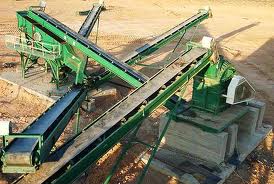Five stages of gypsum production process
Gypsum
Gypsum is a useful mineral material. It is extensively applied as construction material, most of which is produced as plaster for painting walls or
making decorative material in buildings. Some gypsum ore deposits contain about 80% gypsum, which is excellent for producing plaster.
Raw gypsum ore could be processed into a variety of products such as a portland cement additive,soil conditioner, industrial and building plasters, and gypsum wallboard.
Gypsum production process
Gypsum ore, from quarries and underground mines, is crushed and stockpiled near a plant. Asneeded, the stockpiled ore is further crushed and screened to about 50 millimeters (2 inches) in diameter. If the moisture content of the mined ore is greater than about 0.5 weight percent, the ore must be dried in a rotary dryer or a heated roller mill. Ore dried in a rotary dryer is conveyed to a roller mill, where it is ground to the extent that 90 percent of it is less 149 micrometers (µm)(100 mesh). The ground gypsum exits the mill in a gas stream and is collected in a product cyclone. Ore is sometimes dried in the roller mill by heating the gas stream, so that drying and grinding are accomplished simultaneously and no rotary dryer is needed. The finely ground gypsum ore is known as landplaster, which may be used as a soil conditioner.
Five stages of gypsum production line
Gypsum processing equipment differs significantly in scale and level of technology. some plants produce one or two tonnes per day using low-cost manual technologies, some other plants of a thousand tonnes per day that are highly mechanized and capable of producing different types and grades of gypsum plaster or plaster boards.
There are five basic stages in gypsum processing:
- Excavation is sometimes carried out by digging out an area of ground where the gypsum is located using open-cast techniques. To reach deeper deposits drift or shaft mines may be needed. The drilling and digging equipment is applied to dig out the gypsum ore in excavation stages.
- Crushing the gypsum rock is advisable before processing further, especially if subsequent heating is to be done in a pan rather than a shaft kiln. Crushing should reduce the gypsum to grains of less than a few millimetres across. Jaw crusher is the most popular crushing plant for size reduction of big massive material, impact crusher and cone crusher will also be used for fine crushing.
- Screening with a sieve will remove large grains which have not been crushed properly and which may contain impurities.
- Grinding, for example in a ball, rod, or hammer mill, is necessary if the gypsum is to be used for high quality plasterwork or for moulding, medical, or industrial applications. Unlike with other cements, such as lime and Ordinary Portland Cement, special mills for mineral grinding may not be required and the relatively soft gypsum could be pulverised in agricultural mills.
- Heating may be done in a number of ways involving a range of technology levels and costs. rotary dryer will be applied to dewatering the materials, and cyclone collector will gather the final gypsum powder for final application.
SBM is a professional global manufacturer of mining equipment, we could provide complete set of gypsum production line. Our equipment has the benefits of high performance, low operation cost, cost-effective. They have create huge wealth for our customer. If you have interests, please know more about SBM machinery.
source: https://orebeneficiation.wordpress.com/
